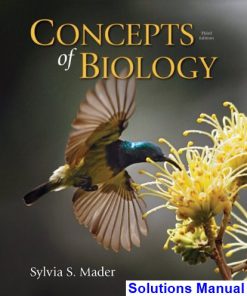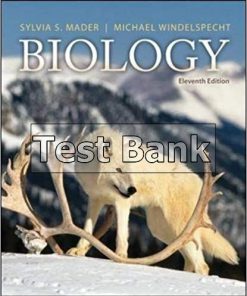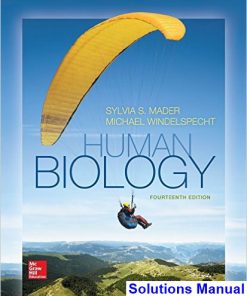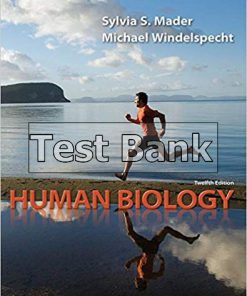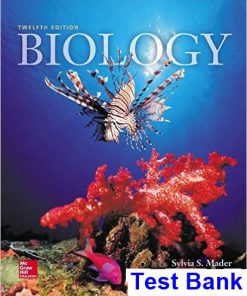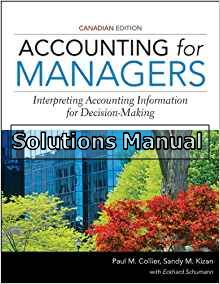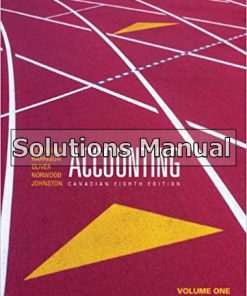Biology 12th Edition Mader Solutions Manual
You may also like
-
$26.50
$50.00 -
$26.50
$50.00 -
$26.50
$50.00
Instant download Biology 12th Edition Mader Solutions Manual pdf docx epub after payment.
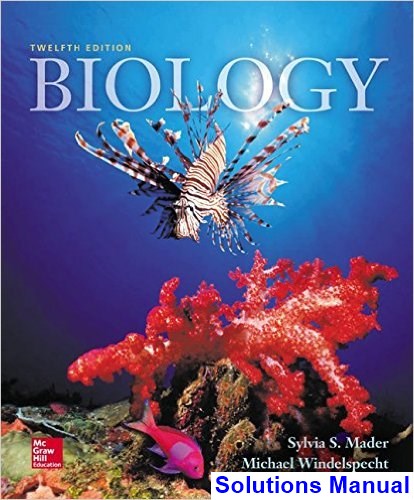
Product details:
- ISBN-10 : 0078024269
- ISBN-13 : 978-0078024269
- Author:
The twelfth edition of Biology is a traditional, comprehensive introductory biology textbook, with coverage from Cell Structure and Function to the Conservation of Biodiversity. The book, which centers on the evolution and diversity of organisms, is appropriate for any one- or two-semester biology course.
Biology, 12th Edition is the epitome of Sylvia Mader’s expertise. Its concise, precise writing-style employs lucid language to present the material as succinctly as possible, enabling students―even non-majors―to master the foundational concepts before coming to class. “Before You Begin”, “Following the Themes”, and “Thematic Feature Readings” piece together the three major themes of the text―evolution, nature of science, and biological systems. Students are consistently engaged in these themes, revealing the interconnectedness of the major topics in biology.
Sylvia Mader typifies an icon of science education. Her dedication to her students, coupled with her clear, concise writing-style has benefited the education of thousands of students over the past three decades.
The integration of the text and digital world has been achieved with the addition of Dr. Michael Windelspecht’s facility for the development of digital learning assets. For over ten years, Michael served as the Introductory Biology Coordinator at Appalachian State University―a program that enrolls over 4,500 non-science majors annually. Michael is the lead architect in the design of McGraw-Hill’s Connect Plus and LearnSmart media content for the Mader series. These assets allow instructors to easily design interactive tutorial materials, enhance presentations in both online and traditional environments, and assess the learning objectives and outcomes of the course.
Table of contents:
chapter 1 A View of Life 1 1.1 How to Define Life 2 1.2 How the Biosphere Is Organized 6 1.3 How Living Things Are Classified 8 1.4 The Process of Science 10 The Cell 18 chapter 2 Basic Chemistry 19 2.1 Chemical Elements 20 2.2 Elements and Compounds 24 2.3 Chemistry of Water 27 chapter 3 The Chemistry of Organic Molecules 35 3.1 Organic Molecules 36 3.2 Carbohydrates 39 3.3 Lipids 42 3.4 Proteins 46 3.5 Nucleic Acids 50 chapter 4 Cell Structure and Function 57 4.1 Cellular Level of Organization 58 4.2 Prokaryotic Cells 62 4.3 Eukaryotic Cells 64 chapter 5 Membrane Structure and Function 83 5.1 Membrane Models 84 5.2 Plasma Membrane Structure and Function 85 5.3 Permeability of the Plasma Membrane 88 5.4 Modification of Cell Surfaces 96 chapter 6 Metabolism: Energy and Enzymes 101 6.1 Cells and the Flow of Energy 102 6.2 Metabolic Reactions and Energy Transformations 104 6.3 Metabolic Pathways and Enzymes 106 6.4 Oxidation-Reduction and the Flow of Energy 110 chapter 7 Photosynthesis 115 7.1 Photosynthetic Organisms 116 7.2 Plants as Solar Energy Converters 118 7.3 Light Reactions 120 7.4 Calvin Cycle Reactions 124 7.5 Other Types of Photosynthesis 126 chapter 8 Cellular Respiration 131 8.1 Cellular Respiration 132 8.2 Outside the Mitochondria: Glycolysis 134 8.3 Inside the Mitochondria 136 8.4 Fermentation 142 8.5 Metabolic Pool 144 Genetic Basis of Life 148 chapter 9 The Cell Cycle and Cellular Reproduction 149 9.1 The Cell Cycle 150 9.2 Mitosis and Cytokinesis 153 9.3 The Cell Cycle and Cancer 158 9.4 Prokaryotic Cell Division 162 chapter 10 Meiosis and Sexual Reproduction 167 10.1 Halving the Chromosome Number 168 10.2 Genetic Recombination 170 10.3 The Phases of Meiosis 172 10.4 Comparison of Meiosis with Mitosis 174 10.5 The Human Life Cycle 176 chapter 11 Mendelian Patterns of Inheritance 181 11.1 Gregor Mendel 182 11.2 One-Trait Inheritance 184 11.3 Two-Trait Inheritance 189 11.4 Human Genetic Disorders 193 11.5 Beyond Mendelian Genetics 196 chapter 12 Chromosomal Patterns of Inheritance 203 12.1 Chromosomal Inheritance 204 12.2 Gene Linkage 209 12.3 Changes in Chromosome Number 212 12.4 Changes in Chromosome Structure 218 chapter 13 DNA Structure and Functions 223 13.1 The Genetic Material 224 13.2 The Structure of DNA 227 13.3 Replication of DNA 230 chapter 14 Gene Activity: How Genes Work 237 14.1 The Function of Genes 238 14.2 The Genetic Code 241 14.3 The First Step: Transcription 243 14.4 The Second Step: Translation 244 chapter 15 Regulation of Gene Activity and Gene Mutations 251 15.1 Prokaryotic Regulation 252 15.2 Eukaryotic Regulation 255 15.3 Genetic Mutations 260 chapter 16 Biotechnology and Genomics 267 16.1 DNA Cloning 268 16.2 Biotechnology Products 270 16.3 The Human Genome Project 273 16.4 Gene Therapy 276 Evolution 280 chapter 17 Darwin and Evolution 281 17.1 History of Evolutionary Thought 282 17.2 Darwin's Theory of Evolution 285 17.3 Evidence for Evolution 292 chapter 18 Process of Evolution 301 18.1 Evolution in a Genetic Context 302 18.2 Natural Selection 306 18.3 Speciation 310 chapter 19 Origin and History of Life 319 19.1 Origin of Life 320 19.2 History of Life 324 19.3 Factors That Influence Evolution 334 chapter 20 Classification of Living Things 341 20.1 Taxonomy 342 20.2 Phylogenetic Trees 346 20.3 Systematics Today 351 20.4 Classification Systems 354 Microbiology and Evolution 360 chapter 21 Viruses, Bacteria, and Archaea 361 21.1 The Viruses 362 21.2 The Prokaryotes 367 21.3 The Bacteria 371 21.4 The Archaea 373 chapter 22 The Protists 379 22.1 General Biology of Protists 380 22.2 Diversity of Protists 382 chapter 23 The Fungi 397 23.1 Characteristics of Fungi 398 23.2 Evolution of Fungi 400 23.3 Symbiotic Relationships of Fungi 408 Plant Evolution and Biology 412 chapter 24 Evolution and Diversity of Plants 413 24.1 Evolutionary History of Plants 414 24.2 Nonvascular Plants 417 24.3 Vascular Plants 420 24.4 Seedless Vascular Plants 421 24.5 Seed Plants 424 24.6 Gymnosperms 424 24.7 Angiosperms 428 chapter 25 Structure and Organization of Plants 437 25.1 Plant Organs 438 25.2 Monocot Versus Eudicot Plants 440 25.3 Plant Tissues 441 25.4 Organization of Roots 444 25.5 Organization of Stems 448 25.6 Organization of Leaves 454 chapter 26 Nutrition and Transport in Plants 459 26.1 Plant Nutrition and Soil 460 26.2 Water and Mineral Uptake 464 26.3 Transport Mechanisms in Plants 466 chapter 27 Control of Growth and Responses in Plants 477 27.1 Plant Responses 478 27.2 Plant Hormones 482 27.3 Photoperiodism 488 chapter 28 Reproduction in Plants 493 28.1 Reproductive Strategies 494 28.2 Seed Development 501 28.3 Fruit Types and Seed Dispersal 502 28.4 Asexual Reproduction in Plants 508 Animal Evolution 516 chapter 29 Introduction to Invertebrates 517 29.1 Evolution of Animals 518 29.2 Multicellularity 520 29.3 True Tissue Layers 522 29.4 Bilateral Symmetry 526 29.5 Tube-within-a-Tube 530 chapter 30 The Protostomes 535 30.1 Advantages of Coelom in Protostomes and Deuterostomes 536 30.2 Molluscs 538 30.3 Annelids 542 30.4 Arthropods 544 chapter 31 The Deuterostomes 555 31.1 Echinoderms 556 31.2 Chordates 557 31.3 Vertebrates 560 chapter 32 Human Evolution 577 32.1 Evolution of Primates 579 32.2 Evolution of Hominids 583 32.3 Evolution of Modern Humans 588 Comparative Animal Biology 594 chapter 33 Animal Organization and Homeostasis 595 33.1 Types of Tissues 596 33.2 Organs and Organ Systems 602 33.3 Homeostasis 606 chapter 34 Circulation 611 34.1 Transport in Invertebrates 612 34.2 Transport in Vertebrates 614 34.3 Transport in Humans 616 34.4 Cardiovascular Disorders 622 34.5 Blood, a Transport Medium 625 chapter 35 Lymph Transport and Immunity 631 35.1 The Lymphatic System 632 35.2 The Immune System 634 35.3 Induced Immunity 644 35.4 Immunity Side Effects 646 chapter 36 Digestion and Nutrition 653 36.1 Digestive Tracts 654 36.2 Human Digestive Tract 657 36.3 Nutrition 664 chapter 37 Respiration 669 37.1 Gas Exchange Surfaces 670 37.2 Human Respiratory System 674 37.3 Respiration and Health 678 chapter 38 Body Fluid Regulation and Excretion 683 38.1 Body Fluid Regulation 684 38.2 Nitrogenous Waste Products 686 38.3 Organs of Excretion 687 38.4 Urinary System in Humans 688 chapter 39 Neurons and Nervous Systems 697 39.1 Evolution of the Nervous System 698 39.2 Nervous Tissue 701 39.3 Central Nervous System: Brain and Spinal Cord 706 39.4 Peripheral Nervous System 710 chapter 40 Sense Organs 719 40.1 Chemical Senses 720 40.2 Sense of Vision 722 40.3 Senses of Hearing and Balance 728 chapter 41 Support Systems and Locomotion 735 41.1 Diversity of Skeletons 736 41.2 The Human Skeletal System 738 41.3 The Human Muscular System 745 chapter 42 Hormones and the Endocrine System 753 42.1 Chemical Signals 754 42.2 Human Endocrine System 756 chapter 43 Reproduction 773 43.1 How Animals Reproduce 774 43.2 Male Reproductive System 776 43.3 Female Reproductive System 780 43.4 Control of Reproduction 784 43.5 Sexually Transmitted Diseases 788 chapter 44 Development 795 44.1 Early Developmental Stages 796 44.2 Developmental Processes 800 44.3 Human Embryonic and Fetal Development 805 Behavior and Ecology 816 chapter 45 Animal Behavior 817 45.1 Behavior Has a Genetic Basis 818 45.2 Behavior Undergoes Development 820 45.3 Behavior Is Adaptive 823 45.4 Animal Societies 828 45.5 Sociobiology and Animal Behavior 830 chapter 46 Ecology of Populations 835 46.1 Scope of Ecology 836 46.2 Characteristics of Populations 838 46.3 Regulation of Population Size 844 46.4 Life History Patterns 846 46.5 Human Population Growth 849 chapter 47 Community Ecology 857 47.1 Concept of the Community 858 47.2 Structure of the Community 861 47.3 Community Development 872 47.4 Community Biodiversity 874 chapter 48 Ecosystems and Human Interferences 879 48.1 The Nature of Ecosystems 880 48.2 Energy Flow 885 48.3 Global Biogeochemical Cycles 886 chapter 49 The Biosphere 899 49.1 Climate and the Biosphere 900 49.2 Terrestrial Communities 903 49.3 Aquatic Communities 913 chapter 50 Conservation Biology 925 50.1 Conservation Biology and Biodiversity 926 50.2 Value of Biodiversity 928 50.3 Causes of Extinction 932 50.4 Conservation Techniques 937 appendix A Answer Key 945 appendix B Classification of Organisms 951 appendix C Metric System 953 appendix D Periodic Table of the Elements 955 Glossary G-1 Credits C-1 Index I-1
People also search:
Biology 12th Edition
Biology 12th Edition pdf
Biology
physics and maths tutor biology
mutation definition biology
biology articles for students

